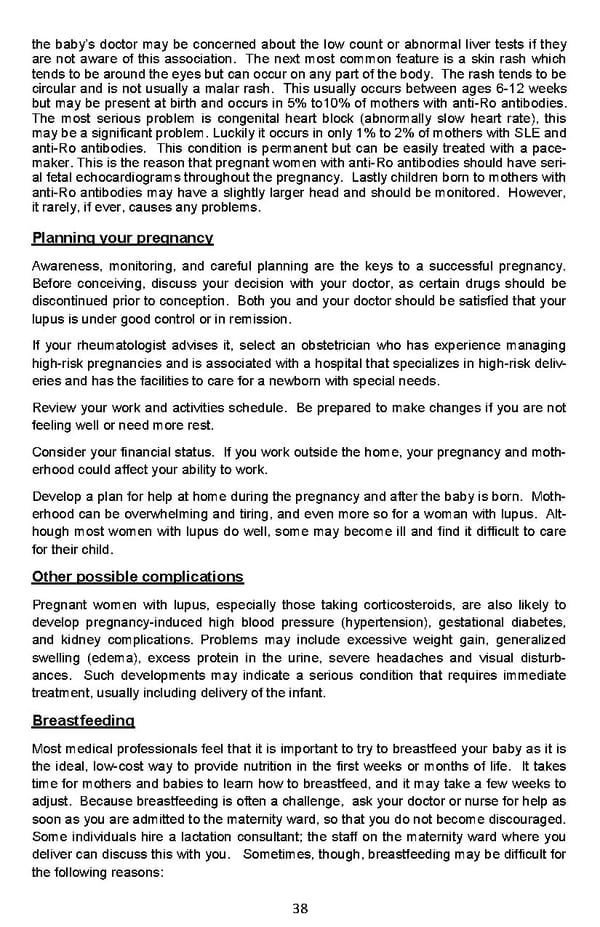the baby’s doctor may be concerned about the low count or abnormal liver tests if they are not aware of this association. The next most common feature is a skin rash which tends to be around the eyes but can occur on any part of the body. The rash tends to be circular and is not usually a malar rash. This usually occurs between ages 6-12 weeks but may be present at birth and occurs in 5% to10% of mothers with anti-Ro antibodies. The most serious problem is congenital heart block (abnormally slow heart rate), this may be a significant problem. Luckily it occurs in only 1% to 2% of mothers with SLE and anti-Ro antibodies. This condition is permanent but can be easily treated with a pace- maker. This is the reason that pregnant women with anti-Ro antibodies should have seri- al fetal echocardiograms throughout the pregnancy. Lastly children born to mothers with anti-Ro antibodies may have a slightly larger head and should be monitored. However, it rarely, if ever, causes any problems. Planning your pregnancy Awareness, monitoring, and careful planning are the keys to a successful pregnancy. Before conceiving, discuss your decision with your doctor, as certain drugs should be discontinued prior to conception. Both you and your doctor should be satisfied that your lupus is under good control or in remission. If your rheumatologist advises it, select an obstetrician who has experience managing high-risk pregnancies and is associated with a hospital that specializes in high-risk deliv- eries and has the facilities to care for a newborn with special needs. Review your work and activities schedule. Be prepared to make changes if you are not feeling well or need more rest. Consider your financial status. If you work outside the home, your pregnancy and moth- erhood could affect your ability to work. Develop a plan for help at home during the pregnancy and after the baby is born. Moth- erhood can be overwhelming and tiring, and even more so for a woman with lupus. Alt- hough most women with lupus do well, some may become ill and find it difficult to care for their child. Other possible complications Pregnant women with lupus, especially those taking corticosteroids, are also likely to develop pregnancy-induced high blood pressure (hypertension), gestational diabetes, and kidney complications. Problems may include excessive weight gain, generalized swelling (edema), excess protein in the urine, severe headaches and visual disturb- ances. Such developments may indicate a serious condition that requires immediate treatment, usually including delivery of the infant. Breastfeeding Most medical professionals feel that it is important to try to breastfeed your baby as it is the ideal, low-cost way to provide nutrition in the first weeks or months of life. It takes time for mothers and babies to learn how to breastfeed, and it may take a few weeks to adjust. Because breastfeeding is often a challenge, ask your doctor or nurse for help as soon as you are admitted to the maternity ward, so that you do not become discouraged. Some individuals hire a lactation consultant; the staff on the maternity ward where you deliver can discuss this with you. Sometimes, though, breastfeeding may be difficult for the following reasons: 38
 Living Well With Lupus Facts Booklet Page 37 Page 39
Living Well With Lupus Facts Booklet Page 37 Page 39